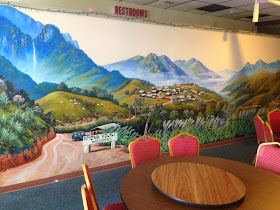This 2013 review of the Hmong House in North St. Paul, Minnesota, perfectly captures the ambience of this restaurant, event hall and community center.
Hmong House, by Dara Moskowitz Grumdahl (MSPMAG.com)
North St. Paul’s new Hmong House is finally the Hmong restaurant Minnesota has been waiting for—with appetizers, beer, and a credit card machine
Diana studied Hmong culture in graduate school, and we made it a point to learn more about the Hmong people while in St. Paul.
To oversimplify for the sake of brevity, the Hmong originated in China, and various migrations took some of them to other locales in Southeast Asia. Among these areas were mountainous regions of Laos, where the Hmong chose the losing side in two wars, first fighting with the French colonizers against the Communists, and later for the Americans during our Vietnam War era.
Consequently, many Hmong were compelled to seek an escape amid genocidal retribution from the victorious Communist authorities in Laos, who only recently have "opened up" sufficiently to invite the Hmong diaspora to return to what is one of the most economically challenged countries in the world. They're being asked to bring their wallets, and many are.
Quite a number of Hmong refugees came to the Twin Cities, where the community is estimated to number more than 100,000. This, then, is the great cause and passion of Pa See and Kay Yang, the power couple who run the Hmong House. In these photos, you'll notice an absence of customers for lunch on a Tuesday afternoon in late July. That's because the Hmong House is packed on weekends for weddings and Hmong social functions. Other paying customers are squeezed inside if there is available space.
We were allowed to order from the dinner menu, and the Yangs threw in a gratis entree (Five-Spice Sweet Braised Pork) as part of the bargain.
The reviewer quoted above describes Hmong food:
For any old hand with Asian restaurants, one of the issues with Hmong food is that you immediately try to identify what’s Thai and what’s Chinese—don’t do that. After a few years of eating Hmong, my best advice is to think about it the way you would Alsatian food. Hmong has an adjacency—some similarities and some differences—to the other southeast Asian cuisines in the same way that Alsatian food has many similarities, many overlaps, and some differences from French food.
Indeed. We had Papaya salad and a delicious Pho, personally spiced by Mr. Yang at the table.
As for my entree, how could I pass on the offer of crispy fried pig intestines ... or as you may know them, chittlins (chitterlings).
They were absolutely fabulous.
At meal's conclusion, we followed the host's directions to the Hmong Village near Lake Phalen, where a former lumber warehouse has been converted into a Hmong multi-vendor market mall, with stalls selling prepared food, bulk food items, vegetables, non-alcoholic drinks, musical CDs, Hmong DVDs, books and virtually anything else an American supermarket would provide.
The Yangs were incredibly giving of their time, and I intend to read a book called The Spirit Catches You and You Fall Down, which Diana read in school. It describes the difficulties in assimilation faced by the Hmong people who've come to America. Mr. Yang, whose earliest memories are of a refugee camp in Thailand, told us that he hopes to be able to retire to Laos. It is my hope to keep in touch with the Yangs, and perhaps find a way to help.
A pop-up Hmong kitchen at BSB?










No comments:
Post a Comment